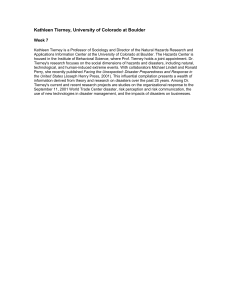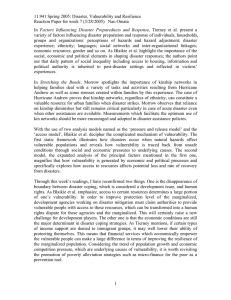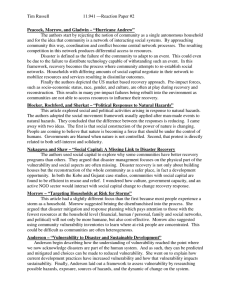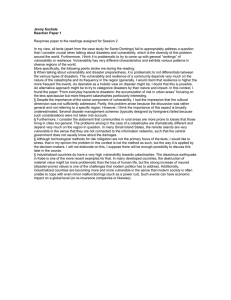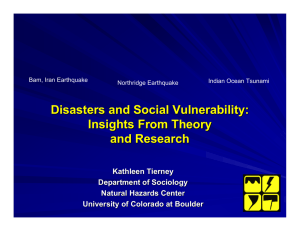Tim Russell 11.941 —Reaction Paper #6 03/28/05
advertisement
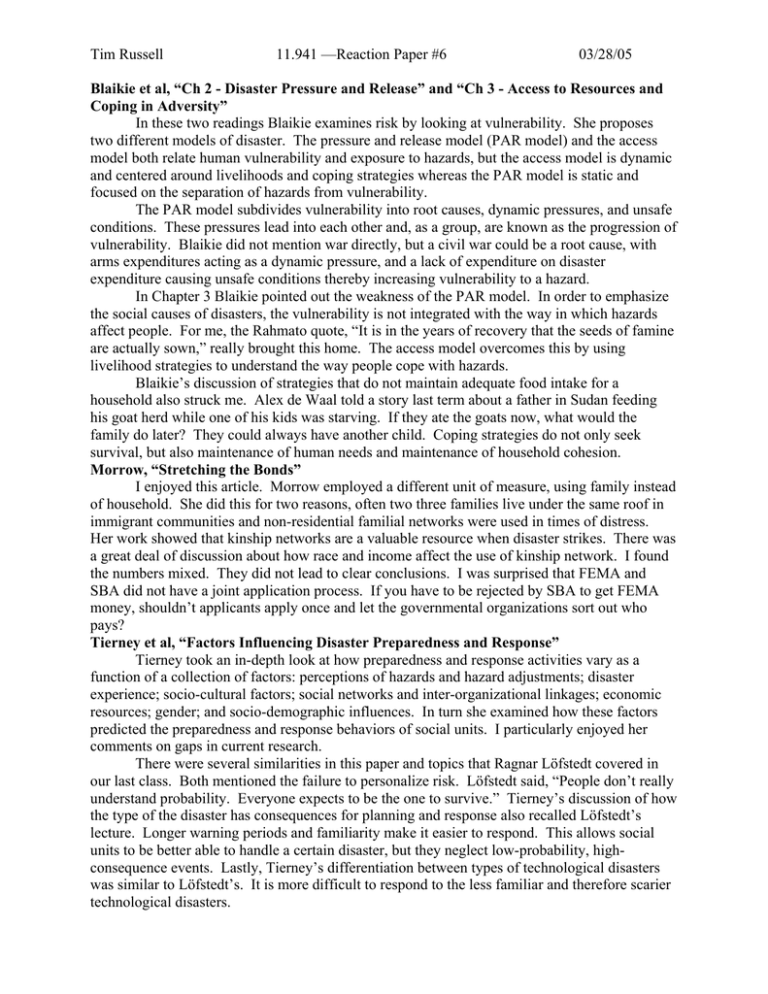
Tim Russell 11.941 —Reaction Paper #6 03/28/05 Blaikie et al, “Ch 2 - Disaster Pressure and Release” and “Ch 3 - Access to Resources and Coping in Adversity” In these two readings Blaikie examines risk by looking at vulnerability. She proposes two different models of disaster. The pressure and release model (PAR model) and the access model both relate human vulnerability and exposure to hazards, but the access model is dynamic and centered around livelihoods and coping strategies whereas the PAR model is static and focused on the separation of hazards from vulnerability. The PAR model subdivides vulnerability into root causes, dynamic pressures, and unsafe conditions. These pressures lead into each other and, as a group, are known as the progression of vulnerability. Blaikie did not mention war directly, but a civil war could be a root cause, with arms expenditures acting as a dynamic pressure, and a lack of expenditure on disaster expenditure causing unsafe conditions thereby increasing vulnerability to a hazard. In Chapter 3 Blaikie pointed out the weakness of the PAR model. In order to emphasize the social causes of disasters, the vulnerability is not integrated with the way in which hazards affect people. For me, the Rahmato quote, “It is in the years of recovery that the seeds of famine are actually sown,” really brought this home. The access model overcomes this by using livelihood strategies to understand the way people cope with hazards. Blaikie’s discussion of strategies that do not maintain adequate food intake for a household also struck me. Alex de Waal told a story last term about a father in Sudan feeding his goat herd while one of his kids was starving. If they ate the goats now, what would the family do later? They could always have another child. Coping strategies do not only seek survival, but also maintenance of human needs and maintenance of household cohesion. Morrow, “Stretching the Bonds” I enjoyed this article. Morrow employed a different unit of measure, using family instead of household. She did this for two reasons, often two three families live under the same roof in immigrant communities and non-residential familial networks were used in times of distress. Her work showed that kinship networks are a valuable resource when disaster strikes. There was a great deal of discussion about how race and income affect the use of kinship network. I found the numbers mixed. They did not lead to clear conclusions. I was surprised that FEMA and SBA did not have a joint application process. If you have to be rejected by SBA to get FEMA money, shouldn’t applicants apply once and let the governmental organizations sort out who pays? Tierney et al, “Factors Influencing Disaster Preparedness and Response” Tierney took an in-depth look at how preparedness and response activities vary as a function of a collection of factors: perceptions of hazards and hazard adjustments; disaster experience; socio-cultural factors; social networks and inter-organizational linkages; economic resources; gender; and socio-demographic influences. In turn she examined how these factors predicted the preparedness and response behaviors of social units. I particularly enjoyed her comments on gaps in current research. There were several similarities in this paper and topics that Ragnar Löfstedt covered in our last class. Both mentioned the failure to personalize risk. Löfstedt said, “People don’t really understand probability. Everyone expects to be the one to survive.” Tierney’s discussion of how the type of the disaster has consequences for planning and response also recalled Löfstedt’s lecture. Longer warning periods and familiarity make it easier to respond. This allows social units to be better able to handle a certain disaster, but they neglect low-probability, highconsequence events. Lastly, Tierney’s differentiation between types of technological disasters was similar to Löfstedt’s. It is more difficult to respond to the less familiar and therefore scarier technological disasters.
